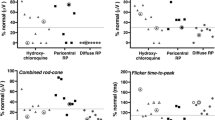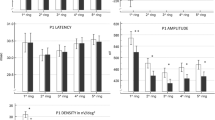Abstract
Twenty patients on Plaquenil treatment were evaluated for retinal toxicity using the (EOG) and the mfERG. Group 1 comprises 15 patients (30 eyes) with normal EOG. From these patients 11 (22 eyes) showed normal RRD of mfERG in area 1 and area 2. The rest four patients (8 eyes) the RRD were reduced. Six months after interruption of HC, the mfERG improved in three cases. Group 2 comprises 5 patients (10 eyes) with subnormal EOG. Four (8 eyes) of these showed a decrease of RRD of the mfERG in area 1 and 2. In the rest one (2 eyes) the RRD were normal. Six months after interruption of HC the mfERG and the EOG improved in 2 cases. These results postulate that the mfERG may be used as an alternative method, perhaps more sensitive, for the detection of the HC retinopathy and the follow up of the patients on hydroxychloroquine.
Similar content being viewed by others
References
Cambiangi A. Unusual lesions in a case of systemic lupus erythematosus. Arch Ophthalmol 1957; 57: 451–453.
Carr RE, Gouras P, Gunkel RD. Chloroquine therapy. Arch Ophthalmol 1966; 55: 171–178.
Shearer V, Dubois EL. Ocular changes induced by long-term Hydroxychloroquine (Plaquenil) therapy. Am J Ophthalmol 1966; 64: 245–252.
Nylander ULF. Ocular damage in chloroquine therapy. Acta Ophthalmol. 1966; 44: 335–348.
Tobin R, Krobel GB, Ryners RI. Hydroxychloroquine: Seven years experience. Arch Ophthalmol 1982; 100: 81–83.
Viopio H. Incidence of chloroquine retinopathy. Acta Ophthalmol 1966; 44: 349–354.
Gouras P, Gunkel RD. The EOG in chloroquine and other retinopathies. Arch Ophthalmol 1963; 70: 629–639.
Zinn KM, Marmor MF. Toxicology of the human pigment epithelium. In: Zinn KM and Marmor MF (eds.) The pigment epithelium, Cambridge, Mass: Harvard University Press, 1979.
Fishman, GA. Toxic retinopathies. Contemporary Ophthalmology 1980; 1: 1–5.
Linda Vu BL, Easterbrook M, Hovis JK. Detection of color visual defects in Chloroquine retinopathy. Ophthalmology 1998; 106: 1799–1803.
Burde RM. Discussion. Ophthalmology 1998; 106: 1804.
Sutter EE, Tran D. The field topography of ERGcomponents in man. I. The photopic lumunance response. Vision Res. 1992; 32: 433–466.
Maturi KR, Folk CJ, Nichols B, Oetting TT, Kardom HR. Hydroxychloquine retinopathy. Arch. Ophthalmol. 1999; 117: 1262–1263.
Ray KM, Folk JC, Nichols B, Oetting TT, Kardon RH. Hydroxychloroquine retinopathy. Arch. Ophthalmol. 1999; 117: 1262–1263.
Infante I, Martin AD, Heckenlively RJ. Hydroxychloroquine and retinal toxicity. In: Kolder HEJW (ed.), Doc. Ophthalmol. Proc. Series, Vol. 37, 1983: 121–126.
Kellner U, Kraus H, Foerster MH. Multifocal ERGin chloroquine retinopathy: regional variant retinal dysfunction. Graefes Arch Clin Exp Ophthalmol 2000; 238: 94–97.
Author information
Authors and Affiliations
Rights and permissions
About this article
Cite this article
Moschos, M.N., Moschos, M.M., Apostolopoulos, M. et al. Assessing hydroxychloroquine toxicity by the multifocal ERG. Doc Ophthalmol 108, 47–53 (2004). https://doi.org/10.1023/B:DOOP.0000018385.99215.0d
Issue Date:
DOI: https://doi.org/10.1023/B:DOOP.0000018385.99215.0d




